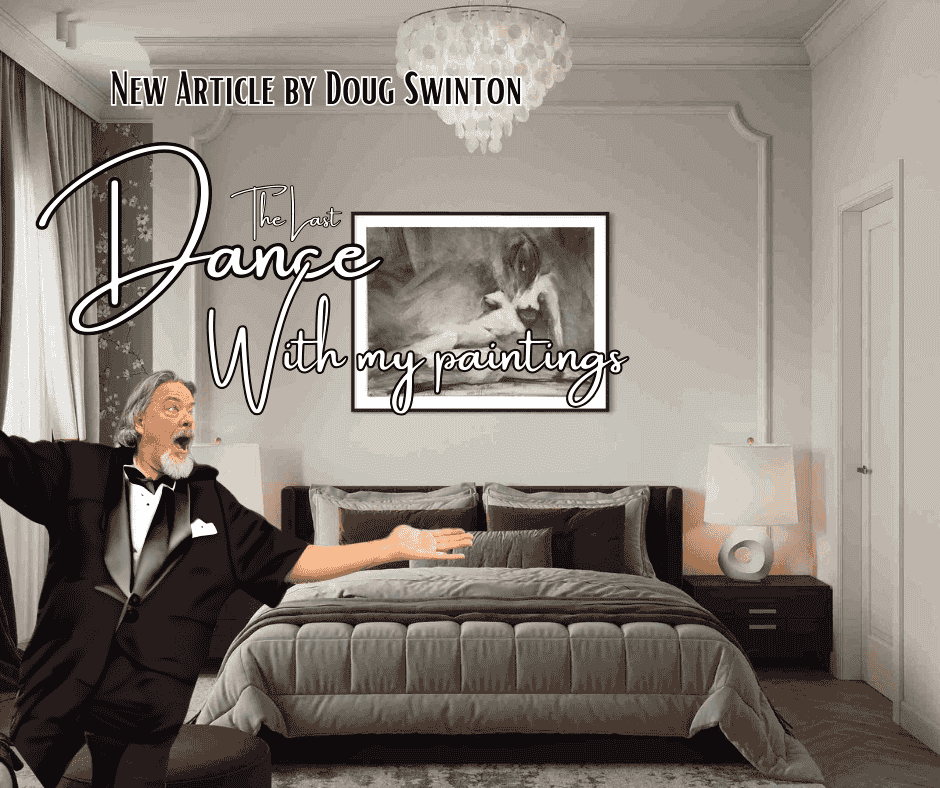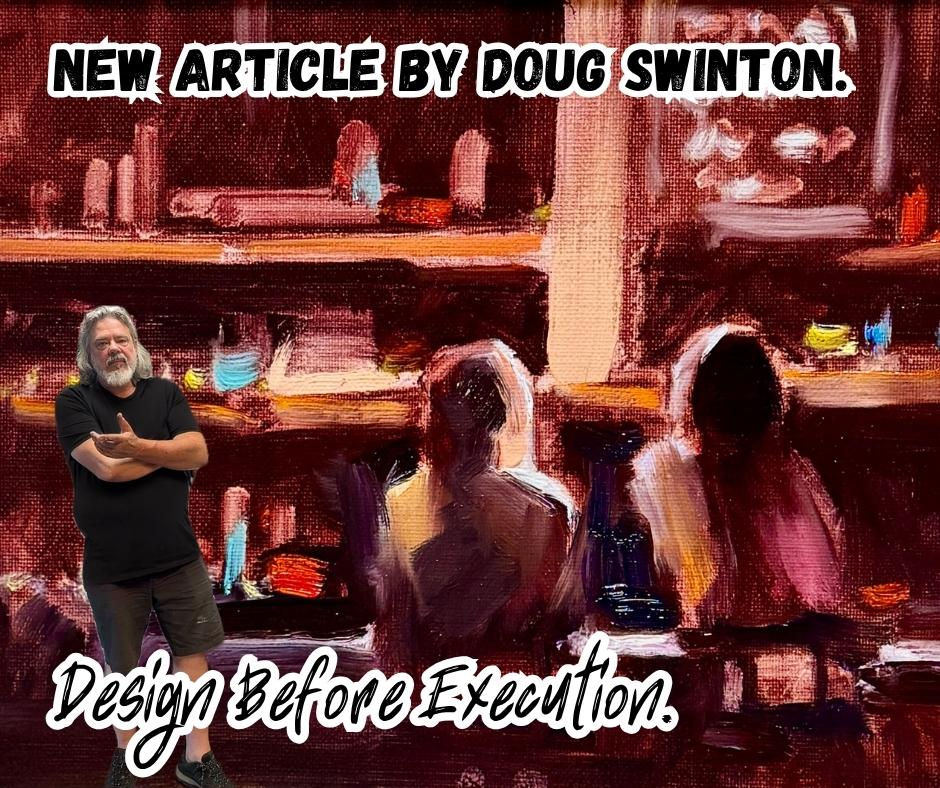4 Types of Light To Consider When Painting
- Doug Swinton

- Apr 9, 2019
- 3 min read
Updated: Mar 15, 2021

There is a never-ending array of possibilities for how light affects the world. You may be using indoor lighting and controlling it yourself or letting mother nature do the work. There is indoor, outdoor, direct light, overcast, mood lighting… but all these variations can be grouped into 4 categories:
Front Lighting, Form Lighting, Rim Lighting and Back Lighting.
Let's dive into each one...
1. Front Lighting
Although this is perhaps the most challenging lighting condition for painters, yet it happens to be the most widely used. Front lighting make for the most lacklustre paintings. This includes all those photo references taken during the middle of the day with almost no shadow. In portraiture, the biggest culprit is using your on-camera flash.
In this lighting condition there are no shadows to help us create the illusion of form. It shows minute detail and limited local values, making for a boring and lifeless painting.

Not enough shadows to work from in this front-lit mountain.

2. Form Lighting
“Winner winner chicken dinner”
This is the easiest and most common set up. As the name implies, this lighting condition helps us define the illusion of three dimensions by giving us a light side and shadow side to create form. It is the painter’s best option for showing three dimensions.
Typically three-quarters to two-thirds of the subject is illuminated by the light. This can also be reversed and is what is sometimes know as “chiaroscuro”. What you don’t want to do is have your lighting so it is half lit and half in the shadow. Half and half might be good for your coffee but not your painting.



3. Rim Lighting
In this lighting condition, the subject is three-quarters or more in the shadow and one-quarter or less in the light. The light is actually coming from behind the subject, creating a brilliant illumination. The lights are compressed within a two value range (typically between 8th and 10th value), so the changes in the light are difficult to determine. Most of the modelling is done in the expanded shadow value range. Fantastic for a dramatic effect.

Great example of Rim Lighting by Matt Smith.

4. Back Lighting
As the name suggest, the light source is behind your subject. Similar to Rim Lighting but with very little or no edge light. This can be difficult to paint but extremely good for creating drama. Be careful not to over-model in your shadows.


Tips to remember:
The lighting for your subject/composition is paramount to the design of your painting. Mediocre lighting is the death of most paintings. The worse the lighting the stronger your design must be.
No matter how little light you have on your subject, you still need to show the type of lighting you are portraying. Neglecting this makes for a flat and lifeless painting. Even if your light is low or poor quality, you still need to show how it affects all the planes on the objects. (Top planes, side planes, oblique planes and front planes.) Bad light is harder to paint but can be done successfully if you pay careful attention to all the planes.
Keep your darks relatively thin and transparent and your lights thick and juicy.
Paint the object that is in the light with local colour plus the colour of the light source. The colour of the light source directly affects the hue on the light side of form. The colour of the light source influences everything.
The chroma in the cast shadow gets slightly weaker as it comes towards the viewer, and stronger as it nears the object casting the shadow.
The less light and shadow you have to distinguish differences, the more you need to use temperature change.
Happy painting. Your friend in art,
Doug.








PUCUK4D PUCUK4D BATAK5D BATAK5D BATAK5D Platform Bermain Situs Toto Togel 4D Online Dan Toto Slot Gacor Resmi Terpercaya Paling Profit Jackpot Maxwin!
Wedding Venues in Chattarpur and MG Road. List of in Chattarpur, Banquet Halls, Hotels for Party pldestinationaces in Chattarpur and MG Road Ever thought of enjoying a multi-theme Wedding Function while being at just one destination? If no then you must not have visited Chattarpur & MG Road Farmhouses.
Party places in NH-8 and Pushpanjali. List of Farmhouses in NH8, Banquet Halls, Hotels for and Pushpanjali Ever thought of enjoying a multi-theme Wedding Function while being at just one destination? If no then you must not have visited NH-8 & Pushpanjali Farmhouses.
Wedding Venue in Delhi
Wedding Venues in Delhi is here to help you find and book the perfect place for your special day. We offer a range of wedding services to make your wedding planning easy and stress-free. We can also customize your wedding according to your budget and preferences.
<a href="https://alohaherbals.com/product/kodein/" rel="dofollow">Actavis promethazine codeine sirup proti kašlju</a>
<a href="https://alohaherbals.com/product/adderall-slovenija/"rel="dofollow">Adderall</a>
<a href="https://alohaherbals.com/product/afghan-black-hash/" rel="dofollow">Afghan Black Hash</a>
<a href="https://alohaherbals.com/product/alazocina/" rel="dofollow">Alazocina</a>
<a href="https://alohaherbals.com/product/blue-meanies-mushroom/" rel="dofollow">Blue Meanies Shrooms</a>
<a href="https://alohaherbals.com/product/medicinske-gobe/" rel="dofollow">BRAZILSKE GOBE</a>
<a href="https://alohaherbals.com/product/burmanske-carobne-gobbles/" rel="dofollow">Burmanske carobne gobbles<a>
<a href="https://alohaherbals.com/product/buy-moon-chocolate-bar-moon-chocolate-bar-wholesale-100-pieces/" rel="dofollow">Buy Moon Chocolate Bar | Moon Chocolate Bar Wholesale 100 Pieces</a>
<a href="https://alohaherbals.com/product/dmt/" rel="dofollow">DMT</a>
<a href="https://alohaherbals.com/product/golden-teacher-mushroom/" rel="dofollow">Goba zlata učiteljica</a>
<a href="https://alohaherbals.com/product/ketamin/" rel="dofollow">Ketamin</a>
<a href="https://alohaherbals.com/product/morfij/" rel="dofollow">Kupite morfij 60mg</a>
<a href="https://alohaherbals.com/product/oksazepam/" rel="dofollow">Kupite Oksazepam 50mg</a>
<a href="https://alohaherbals.com/product/oxycontin-tablete/" rel="dofollow">KUPITE OXYCONTIN 80MG</a>
<a href="https://alohaherbals.com/product/psilocybe-mckennaii/" rel="dofollow">Kupite Psilocybe Mckennaii</a>
<a href="https://alohaherbals.com/product/dilaudid/" rel="dofollow">KUPITI DILAUDID (HIDROMORFON HCL)</a>
<a href="https://alohaherbals.com/product/dormicum/" rel="dofollow">Kupiti Dormicum</a>
<a href="https://alohaherbals.com/product/klonazepam-tablete/" rel="dofollow">KUPITI KLONAZEPAM (KLONOPIN) 2 MG</a>
<a href="https://alohaherbals.com/product/metadon/" rel="dofollow">Kupiti Metadon 40mg</a>
<a href="https://alohaherbals.com/product/metamfetamin/" rel="dofollow">KUPITI OPANA ER (OKSIMORFON HCL)<a>
<a href="https://alohaherbals.com/product/methylone/" rel="dofollow">Kupiti Methylone (BK-MDMA)</a>
<a href="https://alohaherbals.com/product/opana-40mg/" rel="dofollow">Ativan (Lorazepam) 2mg</a>
<a href="https://alohaherbals.com/product/lsd/" rel="dofollow">LSD 100ug</a>
<a…